Through-the- wall air conditioners offers a great energy-efficient and space-saving cooling system. These self-contained units fit through your wall. They are styled like a window AC unit but a hole is actually placed in the wall for them so you don’t lose your window, the chance to open it, and the opportunity for a great view. These units are supported by wall sleeves.
The best part is that the heat is emitted from the exterior of the wall, so it doesn’t negatively impact the temperature of the room.
Through-the-wall units are a permanent cooling option for homes. They are designed to meet the cooling needs of a given room space.
At a Glance: Our Top Picks for Through the Wall Air Conditioners
- OUR TOP PICK: Koldfront WTC14012WCO230V
- RUNNER-UP: Koldfront WTC12001W
- LG LT1016CER
Comparison Chart of the Best Through the Wall AC Units
| IMAGE | PRODUCT | |
|---|---|---|
Our Top Pick 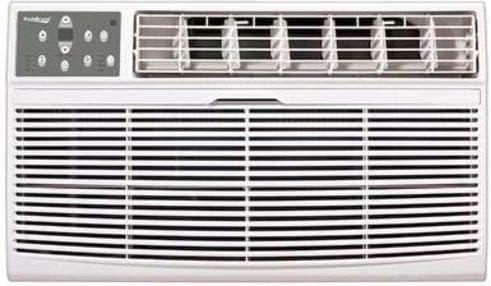 |
| View Latest Price → |
 |
| View Latest Price → |
 |
| View Latest Price → |
 |
| View Latest Price → |
 |
| View Latest Price → |
 |
| View Latest Price → |
How to Choose a Unit
Choosing a Through the-wall AC unit requires you to focus on several parameters apart from the price and cooling ability. Get yourself equipped with the following information before you purchase an AC.
Room Size
The cooling capacity is calculated based on BTUs (British Thermal Units) of the AC. If the unit produces higher BTUs, it can cool a larger room. Of course, how the room is used makes a difference, too – you’ll need a more powerful unit for a kitchen than a bedroom, even if they’re both the same size.
This table will help you determine the BTUs you need based on the square footage of your room. Square footage is the length times the width of your room.
Wall Measurement
Pick the wall and its measurements to correspond to the size of the AC unit. You need to leave enough space around the installation area to allow good ventilation on the exterior side of the wall. It is also important to note the thickness of the wall.

Sunlight
If the room gets more natural sunlight, then you need to consider an AC with higher BTUs. This will allow better cooling around the space.
Ceiling Height
For rooms with a ceiling height more than 8 feet tall, you will need a more powerful unit.
Voltage
Mos newer models require 115 volts, but some larger and older ones require 208/230. An HVAC professional or electrician may be able to add the kind of plug and line you need.
Heat and Other Alternative Modes
Through-the-wall AC units can sometimes provide additional features. The most popular one is the heat mode. Unlike a heater that uses electric heating, these AC units use a heat pump to warm the room during the Winter.
Wall Sleeve
While installing a through-the-wall AC, you also need to pay attention to the type of wall sleeve that goes with it.
A wall sleeve is a metal stand that is installed to hold the outside portion of the air conditioner. There are two types of sleeves – the slide-out chassis and the through-the-wall sleeve.
Slide-out chassis sleeves allow venting from the back and the sides of the unit. They can be used both with both through-the-wall and window units. Often, they are first used with a window unit that’s replaced by a through-the-wall unit.
A through-the-wall sleeve is usually the better option for through-the-wall AC units. These vent out through the rear side only and work best for thicker walls, even beyond 8 inches.
Sleeves are normally sold separately from the unit. So if you’re going out to buy a sleeve, make sure you know the brand and unit dimensions of your AC!
Reviews of the Best Through the Wall Air Conditioners
To make your purchase decision simple, we have brought together a list of TTW AC units from different brands. Note that each one comes with a different cooling capacity.
If you elect to make your purchase of any of these products through Amazon, you can opt for installation for an additional fee right from the product page.
Best Overall
Koldfront WTC14012WCO230V

Specifications
BTU: 14,000
Coverage Area: 700 sq.ft.
Airflow (CFM): 296
Dimensions (in): 20.4×24.3×14.5
Weight: 75.2 lbs.
We may earn commission from purchases made from our links, at no additional cost to you
Review
Koldfront’s through-the-wall air conditioner is an excellent choice in terms of temperature control and functionality. Although it needs a technician’s help to install (with additional spending of a few hundred dollars), it’s a reliable buy.
It stays sealed in the wall and doesn’t take up space on the window or floor. While it might not be the sleekest unit out there, it won’t mess up your house design too much.
The unit can work on schedule due to the 24-hour timer and won’t give you too much trouble during maintenance. It has an easy-to-access washable filter to help you keep the air clean.
In addition to cooling, this air conditioner also dehumidifies and conditions the air, saving you energy.
Bottom Line
This Koldfront AC model also comes in 10,000 and 12,000 BTU powers so that you can choose the best option for your area. Although it might take some work to get it into the wall, you can be sure that this air conditioner will last you for decades.
Pros
24-hour timer
Sleep and energy-saving mode
Temperature range of 62°F – 86°F
High-quality filter and easy-to-access position
Sleek and straightforward remote and a digital control panel on the unit
Cons
Sleeve sold separately
No heating functionality
Runner-up
Koldfront WTC12001W

Specifications
BTU: 12,000
Coverage Area: 550 sq.ft.
Airflow (CFM): 286
Dimensions (in): 20.4×24.3×14.5
Weight: 78.3 lbs.
We may earn commission from purchases made from our links, at no additional cost to you
Review
The Koldfront WTC12001W 12,000 BTU 208-230V Through-the-Wall Heat/Cool Air Conditioner is an excellent through-the-wall air conditioner that you will never regret investing in.
It is simple and easy to install – users report that the whole process, including taking out the wall, will take under fifteen minutes, which is pretty dang great.
This unit boasts some versatility, as in addition to the cooling function, it also has a heating function and a dehumidifying function. Its air vents point in four different directions for maximum cooling/heating/dehumidifying capability.
It can cool down rooms effectively even in rooms with vaulted ceilings, which is quite impressive. Really, there is not much you are not getting when you choose this unit.
Bottom Line
The Koldfront WTC12001W 12,000 BTU 208/230V Through-the-Wall Heat/Cool Air Conditioner is a fantastic unit with a wide range of versatility and a simple installation process that simply can’t be beaten. It does have some inconvenient aspects, such as low energy efficiency, that you should take into consideration, though.
Pros
Has a remote control
Quickly cools down rooms
Works well under constant use
Has three fan speeds and four operation modes
Cons
Loud
Not the most energy efficient
Cleaning the filter can be tricky
LG LT1016CER

Specifications
BTU: 10,000
Coverage Area: 450 sq.ft.
Airflow (CFM): 250
Dimensions (in): 24×20.1×14.4
Weight: 77 lbs.
We may earn commission from purchases made from our links, at no additional cost to you
Review
The LG LT1016CER has a 2016 Energy Star rating of 10.6. Its 9800 BTUs cools a room of approximately 450 sq ft, all things being equal.
You can enjoy cooling flexibility since this AC comes with 3 cooling speeds and 3 fan speeds. It also has an easy-clean mesh filter with a “clean filter” alert.
The unit has LG’s patented gold fin anti-corrosion coating that provides a protective shield, helping preserve your unit for a long time. It is designed to fit into the 26-inch wall sleeve.
Pros
Has a dry mode to avoid humidity buildup
Quiet machine with a great cooling capacity
Fits the wall sleeve used for other similar product brands
The water gets drained from the rear side, keep it out of the way
Cons
Can rattle and get noisy if installation is not done well
Keystone KSTAT12-1C 12000 BTU

Specifications
BTU: 12,000
Coverage Area: 550 sq.ft.
Airflow (CFM): 286
Dimensions (in): 20.3×24.2×14.5
Weight: 75.6 lbs.
We may earn commission from purchases made from our links, at no additional cost to you
This is another through-the-wall AC that has very similar features to LG LT1016CER mentioned above, but carries 12,000 BTUs and can cool a room of about 550 sq ft.
Pros
Cooling capacity and value for the money are big pluses
Money-saving features include an energy saver mode, sleep mode and a programmable 24-hour timer
Cons
May not be the quiet machine you are looking for. It can get noisy over time
Koldfront WTC8001W
Specifications
BTU: 8,000
Coverage Area: 350 sq.ft.
Airflow (CFM): N/A
Dimensions (in): 20.4×24.3×14.5
Weight: 66.6 lbs.
We may earn commission from purchases made from our links, at no additional cost to you
This 8000 BTU AC unit cools an area of 300 – 350 square feet It comes with a remote control and two-year warranty. It has 4-way air directional louvers, three fan speeds and four operation modes. Sleep and energy-saver modes are also among its features. A digital thermostat controls heating and cooling.
Pros
Suitable for both Summer and Winter, as it includes a 4200 BTU with a heat pump of 4200 BTUs.
However, just a word of caution: the heater is only a supplement to the existing heater and does not substitute a heater by itself. That’s not going to be enough power to completely take care of your room.
Cons
You might be turned off by the instruction manual. There are also mixed reviews about ease to install the machine.
Friedrich Chill Premier

Specifications
BTU: 8,000
Coverage Area: 350 sq.ft.
Airflow (CFM): 206
Dimensions (in): 18x19x13
Weight: 51 lbs.
We may earn commission from purchases made from our links, at no additional cost to you
Review
This is a highly recommended through-the-wall AC brand and performs well compared to other 8000 BTUs units – and at a reasonable price. It should comfortably cool a 350 square-foot room with a wall thickness of 7.5 inches.
Some of its winning features include washable antimicrobial filters, “Entrygard” anti-intrusion protection and expandable side curtains. It also has a pretty aesthetic design for something that’s more functional than decorative. As is standard with most units, it has other basic features like a remote control and three fan speeds.
This can be used as a window or through-the-wall unit.
Pros
Has many money-saver features like auto air sweep for more cooling as well as fan cooling
Unlike most units, it comes with a through-wall sleeve for installation. The power cord can be pulled out from both sides of the unit
Cons
Can be a little noisy
Frigidaire FFRH1822R2

Specifications
BTU: 18,500
Coverage Area: 1,050 sq.ft.
Airflow (CFM): 388
Dimensions (in): 25.4×23.6×17.9
Weight: 118 lbs.
We may earn commission from purchases made from our links, at no additional cost to you
Review
The Frigidaire FFRH1822R2 18500 BTU 230V Median Slide-Out Chassis Air Conditioner is an awesome through-the-wall unit with a wide variety of different functionalities. It is also able to heat and dehumidify a space in addition to cooling it, and it has three each of different cool speeds, fan speeds, and heating speeds, for a total of nine main options.
Its different modes include auto mode, in which the fan is able to adjust to the room temperature, and a sleep mode, which slowly increases the temperature after the unit is turned on, which is ideal for falling asleep at night. It can blow cool or warm air in eight different directions thanks to its comfort control design.
And, if you are ever in a situation where you no longer want a through-the-wall unit and instead desire a window unit (such as if you move to a new home where through-the-wall is not an option), this unit also comes with a window mounting kit, so you can really put it wherever would work best for you.
Bottom Line
The Frigidaire FFRH1822R2 18500 BTU 230V Median Slide-Out Chassis Air Conditioner is a fantastic unit that will provide you with a lot of versatility to meet a wide variety of your needs. Just know that if something goes wrong with your unit, Frigidaire is not the greatest at providing solid customer support.
Pros
Quiet
Easy to install
Nice aesthetic
Has a remote control
Does not use a lot of power
Cons
Requires a 230-volt plug to operate
Frigidaire does not provide good customer service
Frigidaire FFTA1233S1

Specifications
BTU: 12,000
Coverage Area: 550 sq.ft.
Airflow (CFM): 286
Dimensions (in): 52.1x61x36.9
Weight: 77.2 lbs.
We may earn commission from purchases made from our links, at no additional cost to you
Review
This 12,000 BTU AC unit from Frigidaire can cool a room up to 550 sq ft. It uses a 115 volts electric outlet. It has the capacity to dehumidify up to 3.3 pints per hour.
It comes with a temperature-sensing remote control that allows you to set the room temperature. It also has ready-select electronic controls. Another feature is the multi-speed with 4-way directional fan control.
Pros
A long lasting product
The sensor controls and remote control are some of the most popular features
Another quiet and very energy efficient AC that can keep your electricity bills low
With low ceilings and limited sunlight, this unit can cool larger rooms than the product promises
Cons
None
Kenmore Smart 04277127
Specifications
BTU: 12,000
Coverage Area: 550 sq.ft.
Airflow (CFM): 265
Dimensions (in): 22.2x 23.6×15
Weight: 81 lbs.
We may earn commission from purchases made from our links, at no additional cost to you
Review
The Kenmore Smart 04277127 Room Air Conditioner is the through-the-wall air conditioner of the future – that is right, everyone, here is an air conditioner with WiFi capability at last! You can download the Kenmore Smart AC app to your smartphone or smart device (including tablets, and the app is compatible with both iPhone and Android smartphone models). If you do not have a smartphone or are not technologically inclined, you can also control this unit using a remote control.
It has four different modes: fan, cool, dry, and eco. Eco will save you substantial money on energy costs. But beyond all of the bells and whistles on this unit, it is also just a straight up awesome through-the-wall AC.
It has adjustable “fins” which will help direct airflow to exactly where you need cool air the most. It is simple and easy to operate, WiFi or no. It is quiet, even when turning on or powering down. If you invest in a Kenmore Smart 04277127 Room Air Conditioner, you will be one happy (and cool!) camper.
Bottom Line
The Kenmore Smart 04277127 Room Air Conditioner is a great unit with the newest and coolest technological features. It is a little confusing to read through the instructions, though.
Pros
Rapidly cools down spaces
Well made of high-quality material
Kenmore provides good customer service
Easy to start up the WiFi system using the app
Cons
Installation instructions are confusing
Advertised as being compatible with amazon’s “Alexa,” but this is not actually the case
Through-the-Wall vs Window AC Units
Through-the-wall and window air conditioners are very similar. But, they have some differences that make people choose one over the other.
Window units are, of course, installed in the windows. But typically, air conditioners are not built to fit any particular window. Further customizations have to added to avoid seepage after installation. Window air conditioners typically vent out the heat from the sides and the back. Through-the-wall units only vent from the back, helping to lower the amount of warm air that makes its way back into your room.
Window units are preferred by those who like to be able to put the unit away when not in use. These units are kept in action during summers and stored in winters. But, for those who do not want to meddle with the AC unit and prefer a permanent solution, it’s a good choice to install a through-the-wall AC unit.
Installation Advantage
If you choose to purchase a window air-conditioner, then you need to be sure that the window measurement complements the AC unit. When you install a through-the-wall unit, you can just have the hole cut to your needs.
While a through-the-wall unit can be slid out, it may not always be necessary. So you have a hole in the wall but you don’t have to move the AC annually.
Window units are easier to install and uninstall and don’t leave a lasting mark on your house. But here, it’s an issue of a one-time installation versus an annual process of setting up and removing a window unit.
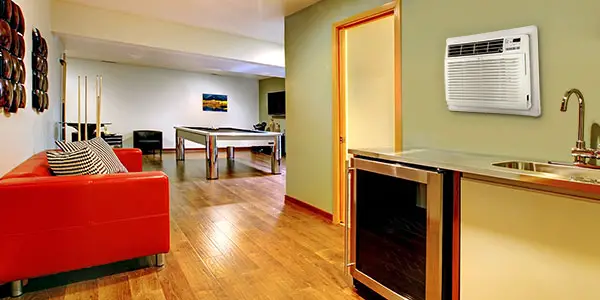
Space Consumption and Cooling Capacity
Both types of unit stay pretty much out of the way. Through-the-wall units also allow you to keep your windows as it is. They can pretty much be placed anywhere on the wall.
If you need to cool a small room, then you can do away with window units in less than $200. Both types of air conditioners come in much larger capacities, too, of course.
Price and Energy Efficiency
A notable difference is that through-the-wall units are more energy-efficient than window units. Window air conditioners are cheaper than through-the-wall ACs. So you’re looking at the difference between up-front savings and long-term savings. That will make through-the-wall units more effective in the long term – as long as you have the initial budget to pay for it.
- Check the power source and make sure you match it with the outlet. Make sure the voltage required for the AC unit is available at home. Through-wall ACs use standard 110-120-volt plugs, but some larger or older units may also use 220 volts.
If your house does not support the voltage, consult an electrician to install special electrical wiring.
Be sure the power cord that comes with the unit is long enough. It’s never a good idea to use extension cords or splice cords to make it longer.
How Hard Is It to Install?
Installing a through-the-wall AC unit is a clean affair provided the right professional works on it. This is because apart from electrical work, you actually need to have a hole put in the wall. Some of the points to keep in mind before trying it yourself are:
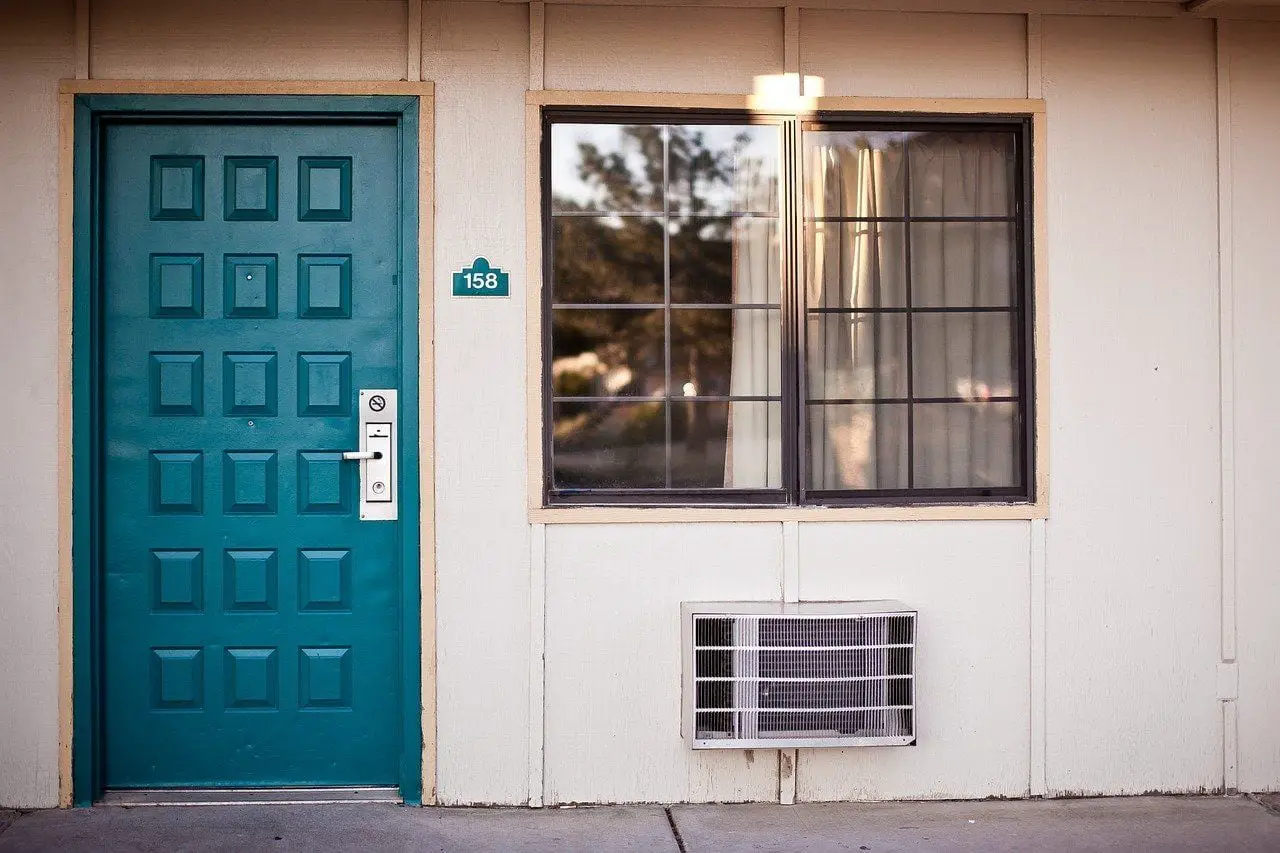
- Check carefully that you’re not going to be interfering with existing pipes or wiring.
- Check the unit and sleeve dimensions before digging the hole.
- Take into consideration the wall thickness.
- Be sure that you are choosing the right wall in the room. For that, you probably want an HVAC professional, not just a carpenter.
- These ACs need to be vented so be certain it’s an exterior wall.
- Once the wall to be used for installation is chosen, work towards the electrical details.
What Size Through-The-Wall Air Conditioner Do I Need?
Choosing the right size for your through-the-wall air conditioner is much like picking any unit. The most critical number to know here is the area you intend to cool. Measure the length and width of the room.
Once you have the number, there are a few options to find the cooling power of the unit you need in BTU:
- Use the BTU formula
- Find a BTU vs. cooling area table
- Use a BTU calculator to consider more factors
Using the first two options is an approximation. Getting the calculator to do the thinking for you is the better option. It asks a few additional questions to determine the exact size. Here are some of them:
- Is the room getting a lot of sunlight?
- Are there any large appliances in the room that emit heat?
- How many people occupy the space on a typical day?
Answering these questions can give you a better understanding of the unit’s capacity.
Top Brands in the Through-the-Wall AC Space
Although through-the-wall air conditioners aren’t as popular as window units or mini-splits because of more tricky installation and maintenance, top brands still innovate in this area. Let’s note the top brands in the market.

Midea
Midea Group is a Chinese home appliances manufacturing company with more than 260 logistic centers and 21 production facilities in 195 countries. It employs 150,000 people worldwide and has an annual global revenue of $40,5 billion.
With research, development, and tireless innovation, Midea has managed to create super-friendly house appliances. It produces everything from dishwashers to air conditioners. Their through-the-wall units are sold under their Arctic King AC line.
The units are affordable and start at 8,000 BTU, going up to 14,000. The product line makes it a straightforward choice for customers. Just choose the size and decide if you want a unit with a heater. Easy.
Friedrich
Refrigeration history enthusiasts would know that this brand has been in the market for around 130 years since Ed Friedrich founded his business.
It used to be a furniture manufacturing endeavor before becoming one of the most significant commercial refrigerator productions in North America.

In the early 1950s, the company started expanding into room cooling and produced their first window AC units. With its different product lines like Kühl, WallMaster, and Chill, the brand keeps innovation at its forefront.
They introduced the Variable Refrigerant Packaged Heat Pump system in 2017, and the Friedrich FreshAire system launched in 2018. This company’s products give customers top-quality solutions for commercial and residential facilities.
Their through-the-wall ACs have adapted over time and include smart capabilities as well.
Who Should Not Buy a Wall Mounted AC?
Although through-the-wall air conditioners are out of the way and can be highly efficient compared to the window and portable units, there’s a reason why they aren’t that popular. This section explains some disadvantages of these air conditioners.
Need to Cool More Than One Room
Although you can say the same about most AC types, including mini splits and window units, through-the-wall ACs are also pricey to install.
We believe this combination of cutting out walls to install the appliance and having it only in one room can be why people don’t pick these units all too often.

Building Constraints
In many cities, building codes or zoning laws won’t let you attach a large permanent AC on the facade. While installing a window unit might be easier and not pose an issue in some places, through-the-wall systems are challenging to accommodate.
Maintenance and Cleaning Restrictions
Although these units might not need too much maintenance on the customer’s side (only vacuuming or washing the filter), the outdoor section can be tricky to clean during the seasonal checkup.
This statement might not be accurate for houses, but those living in residential buildings might feel the restrictions.
No Permanence Needed
The through-the-wall unit’s permanence is what might throw people off sometimes. If you own the house, this won’t be an issue. Still, if you’re renting, you might not want to install an expensive system just to leave it to the landlord while moving.
In these cases, most tenants opt for a window or portable AC.
Pros and Cons of Through-The-Wall Air Conditioners
Similar to the various units out there, through-the-wall air conditioners have both good and bad aspects. Knowing about them in-depth will help you decide if these units are right for you.
Pros
Following are some reasons why you should consider these products:
Energy-Efficient
Wall A/C units are not only aesthetically pleasing; they also help to keep the room cool and comfortable. They are installed in a pre-set wall sleeve, which offers additional support to the AC unit. Moreover, the tight fit creates an airtight seal around the AC unit, thus preventing unwanted drafts from entering the room, thus increasing the efficiency of these units.
Enjoy the View From Your Window
Through-the-wall air conditioners are installed in the wall, thus ensuring that the view from your window is not obstructed. A window unit, on the other hand, would block the view from your window, which can be quite annoying.
Less Noisy
Wall A/C units are much quieter as compared to window air conditioners. Although they might make some noise as they are in constant contact with the wall, however, it is much less than the noise produced by window air conditioners.
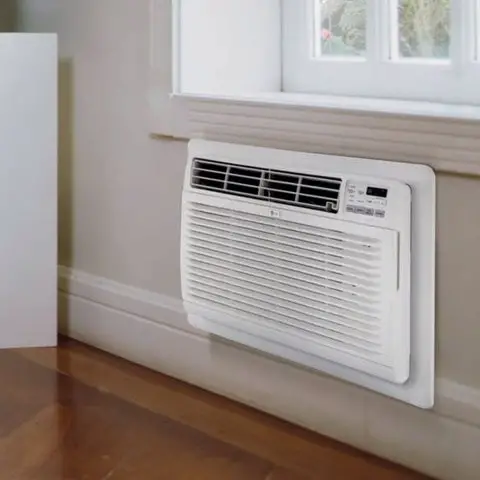
Cooling Capacity
As compared to window air conditioners, wall units have a much better cooling capacity. With better fans and more BTUs, wall air conditioners can cool a room much faster.
They are designed with internal thermostats that shut down when the room reaches a certain temperature, thus saving huge sums in utility bills.
Cons
Following is the primary disadvantage of this type of product:
Requires Maintenance
The lifespan of a wall unit is greatly determined by the maintenance executed on it. Proper maintenance will ensure that your unit may last for as long as ten years.
However, if you do not pay any attention to its maintenance and run it year after year without changing the air filter or examining the hoses, you might find yourself replacing the unit within a few years.
Conclusion
Through-the-wall air conditioning units are most popular among those who want to save up the window space and keep this as a permanent cooling system.
However, keep in mind that this involves installation and requires professionals to work on it. On the whole, this would be great value for money considering the energy efficiency that you will enjoy.
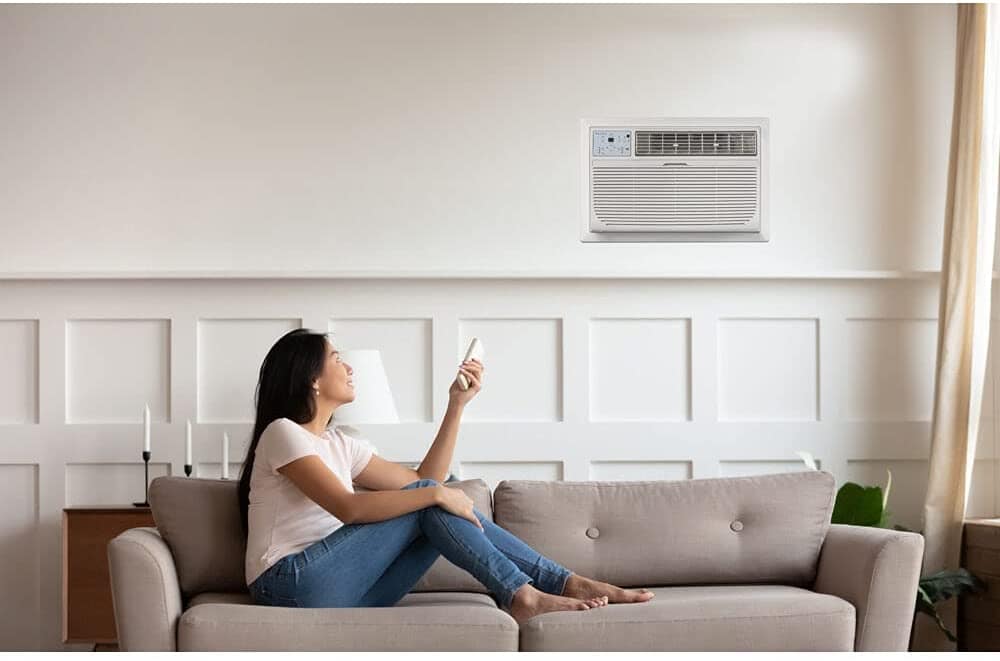
People Also Ask
Through-the-wall air conditioners are a great option for buildings and homes that do not have a central air conditioning system. They are economical and come with many great features. However, before buying a unit, it is best to have complete information about it. The following questions will provide additional information, thus making it easier to choose a unit best suited to your needs:
Installing a through-the-wall AC is a five-hour job for a professional, and it’s going to take almost a full day if you decide to do it yourself. Professional mounting will cost anywhere between $600 to $800, and the DIY will save you around 26%.
The efficiency of a through-the-wall AC depends on many factors. It’s slightly more efficient than window units, as the sealing around the air conditioner is tighter than the foam around the window unit. It’s much more efficient than portable systems.
Through-the-wall units usually last 15 to 20 years if you maintain the system well, clean the filters, and do periodic checks.
Unfortunately, through-the-wall ACs are similar to the wall-mounted and window units in this sense. They produce enough cool to fill one room but can hardly affect other spaces without making the initial one too cold.
The features depend on the model, but you can find ones that do.
These are self-contained A/C units that cool the rooms quickly. They are installed through an exterior wall with the help of a wall sleeve for support.
These units suck the hot air present in the room. This air is then cooled in the air conditioning condenser to cool. This cool air is then pushed back into the room. These units condense the moisture from inside the room and drain it outside. Thus this lowered humidity helps you feel cooler.
Winterizing your air conditioner is important so that your house remains warm and toasty during winters. Also, this ensures that your unit is ready when the summer months come. There are several things that can help you winterize your unit:
1. Get an air conditioner winterization kit from a home improvement store. These kits typically include heavy-duty plastic that you can place on the outside of your air conditioner. This stops the cold air from entering your home. You can also seal the plastic, thus effectively closing all the gaps.
2. You can also cover these units with metal covers. Made from heavy-duty sheet metal, these covers fit snugly over the unit.
The best height for a window A/C is three to four feet from the floor in a ten feet high room.
